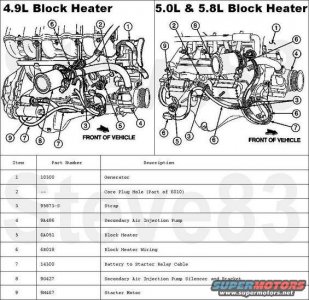Yo HIDDEN,
Installation; "... In some climates, and often for diesels in any climate, some freeze plugs are replaced by a block heater; most often with a common plug for 110VAC household power routed to the grille so that it can be plugged into an extension cord overnight..."
Freeze Plugs & Block Heater
Core Plugs
Removal and Installation
To remove a large core plug, drill a 12.70mm (1/2-inch) hole in the center of the plug and remove with an Impact Slide Hammer T59L-100-B or T50T-100-A or pry it out with a large drift punch. On a small core plug, drill a 6.35mm (1/4-inch) hole in the center of the plug and pry it out with a small pin punch. Clean and inspect the plug bore.
Prior to installing a core plug, the plug bore should be inspected for any damage that would interfere with the proper sealing of the plug. If the bore is damaged, it will be necessary to true the surface by boring for the next specified oversize plug.
Oversize (OS) plugs are identified by the OS stamped in the flat located on the cup side of the plug.
Coat the plug and/or bore lightly with an oil-resistant (oil galley) Sealing Compound E0AZ-19554-B or EZAZ-19544-B or equivalent and install it following the procedure for cup-type or expansion type below:
Cup-Type
Cup-type core plugs are installed with the flanged edge outward. The maximum diameter of this plug is located at the outer edge of the ******. The ****** on cup-type plugs flares outward with the largest diameter of the outer (sealing) edge.
Expansion-Type
Expansion-type core plugs are installed with the ****** edge inward. The maximum diameter of this plug is located at the base of the ****** with the ****** flaring inward.
CAUTION: It is imperative to push or drive the plug into the machined bore using a properly designed tool. Under no circumstances is the plug to be driven using a tool that contacts the crowned portion of the plug. This method will expand the plug prior to installation and may damage the plug and/or plug bore.
When installed, the trailing (maximum) diameter must be below the chamfered edge of the bore to effectively seal the plugged bore.
If the core plug replacing tool has a depth seating surface, do not seat the tool against a non-machined (casting) surface.
CAUTION: It is imperative to pull the plug into the machined bore by using a properly designed tool. Under no circumstances is the plug to be driven into the bore using a tool that contacts the ******. This method will damage the sealing edge and will result in leakage and/or plug blowout.
The flanged (trailing) edge must be below the chamfered edge of the bore to effectively seal the plugged bore.
If the core plug replacing tool has a depth seating surface, do not seat the tool against a non-machined (casting) surface.

Engine Block Heater
View attachment 29071
1. Open radiator draincock (8115) and remove coolant from radiator (8005) and engine (6007).
2. Remove block heater (6A051). Note the position that the element is pointed (eg. 12:00, 6:00, etc.)
3. Clean the inside diameter of the core plug hole machined surface and hole entrance. Remove any burrs at the hole entrance to avoid damage to the O-ring.
4. Cover rubber O-ring and core opening with a liberal coating of chassis grease (C1AZ-19590-B, C, D, E or equivalent.
5. Insert block heater in core plug hole in the same position as it was removed.
6. Tighten ***** in normal clockwise direction. Torque to 1.6-1.8 N-m (14-16 lb-in).
7. Refill cooling system.
I haven't found any Ford documentation, but a '97 GM turbo diesel uses a 22-Ohm (650W, 5.5A@120VAC) heater, and a '92 non-turbo F350 uses a 16-Ohm (900W, 7.5A@120VAC) heater.
Smallblock V8s take 1.5" freeze plugs & heaters; 4.9L takes 1.625".
Replacement Ford cords: FLEETGUARD 251919, KATS 28216, ZeroStart 3600008
View attachment 29070
by Steve



